Prepared by Dr Carla van Laar and Dr Lisa Mosely for the ACTivate Arts Therapy Campaign
Evidence for the efficacy of Arts Therapy in mental health and wellbeing.
The World Health Organisation (WHO) has confirmed the effectiveness of the arts and arts therapies for helping people experiencing mental illness at all stages of the life course.
The World Health Organisation (WHO) has confirmed the effectiveness of the arts and arts therapies for helping people experiencing mental illness at all stages of the life course. A core strength of Arts Therapy is that it responds to the needs of each person rather than a one-size-fits-all approach. The WHO Report finds specifically that the beneficial impacts of arts therapy could be furthered through better acknowledging and acting on the growing evidence base (WHO Health Evidence Network Synthesis Report 2019)
An Australian review of the efficacy of the Arts Therapies (2013) found that
the effectiveness of creative arts therapies for a range of conditions is indicated. For music therapy, these are adults experiencing cancer, terminal illness, dementia and depression, and children diagnosed with Autism Spectrum Disorder. For arts therapy these are mental illness, asthma, depression and coping with breast cancer. For dance-movement therapy these are schizophrenia, cancer, depression, stress, emotional eating and dementia. Drama therapy has been documented to reduce behavioural issues for school students. However, all of these modalities are practiced around the world with a range of clients and conditions far broader than these results would indicate, pointing to significant opportunities for further research.
Both of these reviews promote a strong opinion that further research will continue to strengthen the evidence base.
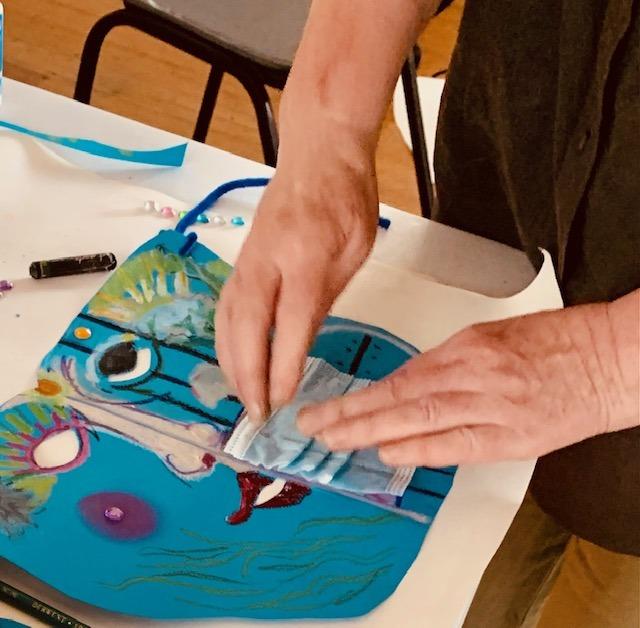
Expert opinion
“Arts Therapists can play a role in the new Mental Health Practitioner in Schools program. It is a lateral solution to a very real need. They are essential allies in the Mental Health workforce and have the skills and training to address this major threat to mental health in our community“
Professor Patrick McGorry
Expert opinion concurs that Arts Therapy and Arts Therapists are effective and particularly appropriate in supporting mental health and well-being in schools.
Professor Patrick McGorry, AO, Executive Director of Orygen and Professor of Youth Mental Health at the University of Melbourne, has made a statement to support the employment of Arts Therapists in the Mental Health Practitioner in Schools positions. Pat is a psychiatrist known world-wide for his development and scaling up of early intervention and youth mental health services and for mental health innovation, advocacy and reform. He says:
Arts Therapists can play a role in the new Mental Health Practitioner in Schools program. It is a lateral solution to a very real need. They are essential allies in the Mental Health workforce and have the skills and training to address this major threat to mental health in our community. – Please see Prof McGorry’s full statement below.
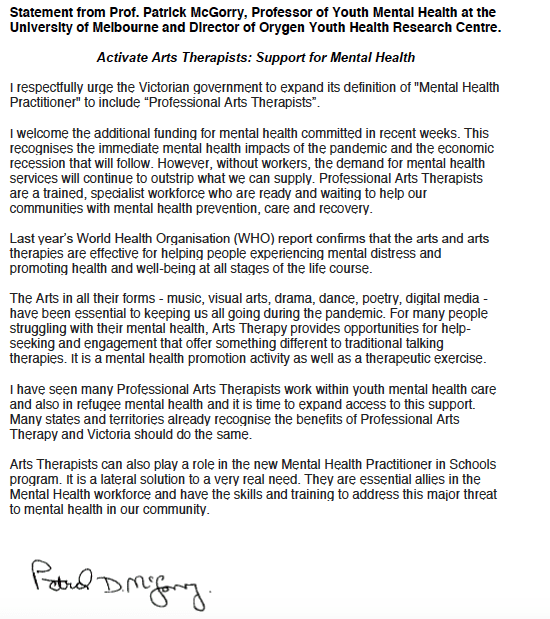
Jill Gallagher AO, CEO of the Victorian Aboriginal Community Controlled Health Organisation, VACCHO, and former Treaty Advancement Commissioner, has likewise written in support of the employment of Arts Therapists in the Mental Health Practitioner in Schools positions:
I would love to see our young people able to see an Arts Therapist in schools. Before 2020, of course, many of our young ones were already struggling with their mental health and/or caring for someone else experiencing trauma/mental illness. Taking the first step to seek support can be difficult and we already know that using arts as a vehicle can and does help… Activating Arts Therapists to fill mental health jobs in schools and other settings is an important campaign and I support it wholeheartedly. Let’s get this done.

Protocols for the regulation of Professional Arts Therapists
Professional Creative Arts Therapists are members of an industry recognised registration body such as PACFA – the Psychotherapy and Counselling Federation of Australia.
This includes regulation of:
- adherence to a code of ethical conduct,
- insurances,
- continuing professional development requirements
- clinical supervision requirements
In Australia, Arts Therapists are included in the Allied Health Professions award and are represented by the Allied Health Professions Australia (AHPA), the recognised national voice for allied health professions in Australia.
Core competencies of tertiary qualified Creative Arts Therapists in Victoria
Only tertiary qualified Creative Arts Therapists who hold AQF recognised Bachelor Degrees or higher are qualified to work in schools.
- Only tertiary qualified Creative Arts Therapists can gain professional registration
- approved training programs in Australia meet the Government requirements of AQF Level 7 and are regulated through TEQSA. The AQF accreditation of courses ensures that Creative Arts Therapy graduates of Australian qualifications apply knowledge and skills to demonstrate autonomy, expert judgement, adaptability and responsibility as a practitioner or learner.
- in keeping with international standards, these regulated AQF training programs include a supervised clinical placement.

Evidence that Arts Therapy can be a proactive, preventative, health promoting approach to mental health that supports protective factors in schools
Arts Therapy increases help seeking and resilience, decreases anxiety and poor coping with young people in schools.
“there were significant mental health benefits for students. There was an overall 24.95% increased knowledge of triggers to anxiety, along with a 55.15% increased knowledge of coping strategies and a 25.05% increased intention to help-seek amongst the students”
The “Chill Skills” program was designed by Arts Therapist, Carla van Laar, who was employed by headspace, the National Youth Mental Health Foundation, and the program was initially funded by School Focused Youth Services. It was deliveredin four Victorian Secondary Colleges in Melbourne’s Western suburbs.
Evaluation of the pilot projects was designed in consultation with psychiatrist, Professor Dan Lubman, AM. Dan is Executive Clinical Director, Turning Point and Professor of Addiction Studies and Services, Monash University. Professor Lubman has worked across mental health and drug treatment settings in the UK and Australia. His research is wide-ranging and includes investigating the harms associated with alcohol, drugs and gambling, the impact of alcohol and drug use on brain function, the relationship between substance use, gambling and mental disorder, as well as the development of targeted telephone, online and face-to-face intervention programs within school, primary care, mental health and drug treatment settings.
The “Chill Skills” project was firstly delivered and evaluated in two secondary schools, and the findings of the evaluation resulted in an award of $80,000 NAB Schools first funding so it could be delivered in two further secondary schools.
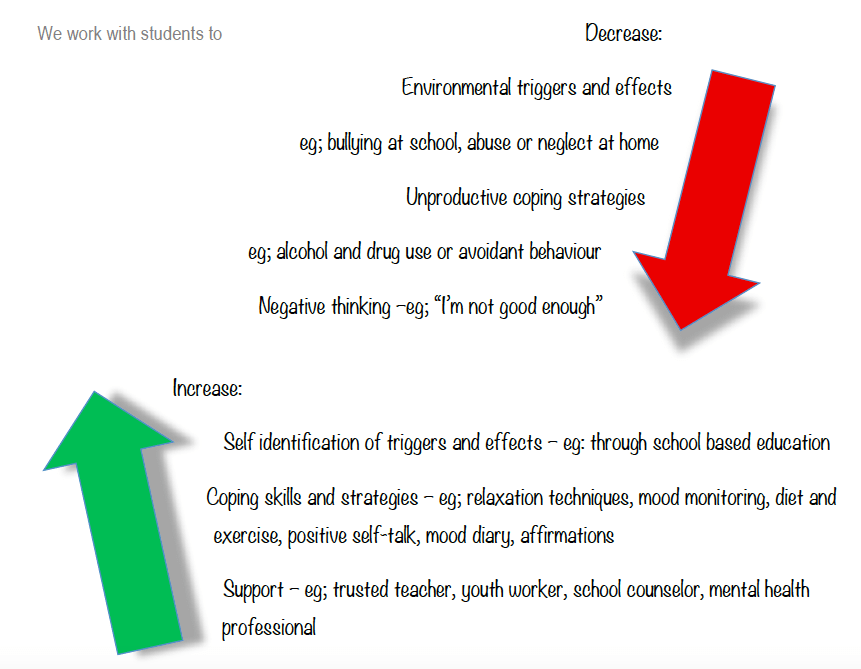
Across the two pilot projects, there were significant mental health benefits for students. There was an overall 24.95% increased knowledge of triggers to anxiety, along with a 55.15% increased knowledge of coping strategies and a 25.05% increased intention to help-seek amongst the students.
This increase in understanding and knowledge about anxiety, along with an increased intention to seek help for anxiety are significant because they are indicators of resilience.
Students’ average use of productive coping strategies increased from 61.3% to 68.6%, an improvement of 7.3%. Productive coping includes skills like trying to solve the problem and getting enough rest.
The students’ average ‘reference to others’ (seeking others’ help) also increased from 52.1% to 57.9%, up 5.8%. Reference to others is an important coping skill that includes asking others for help, or help seeking, one of the most significant factors in early intervention.
Non-productive coping strategies include responses that don’t help the situation and can even have negative impacts or make it worse, such as using alcohol or other drugs, or fighting with people. The average non-productive coping styles amongst group members reduced from 54.6% to 49.1%, a desirable decrease of 5.5%.
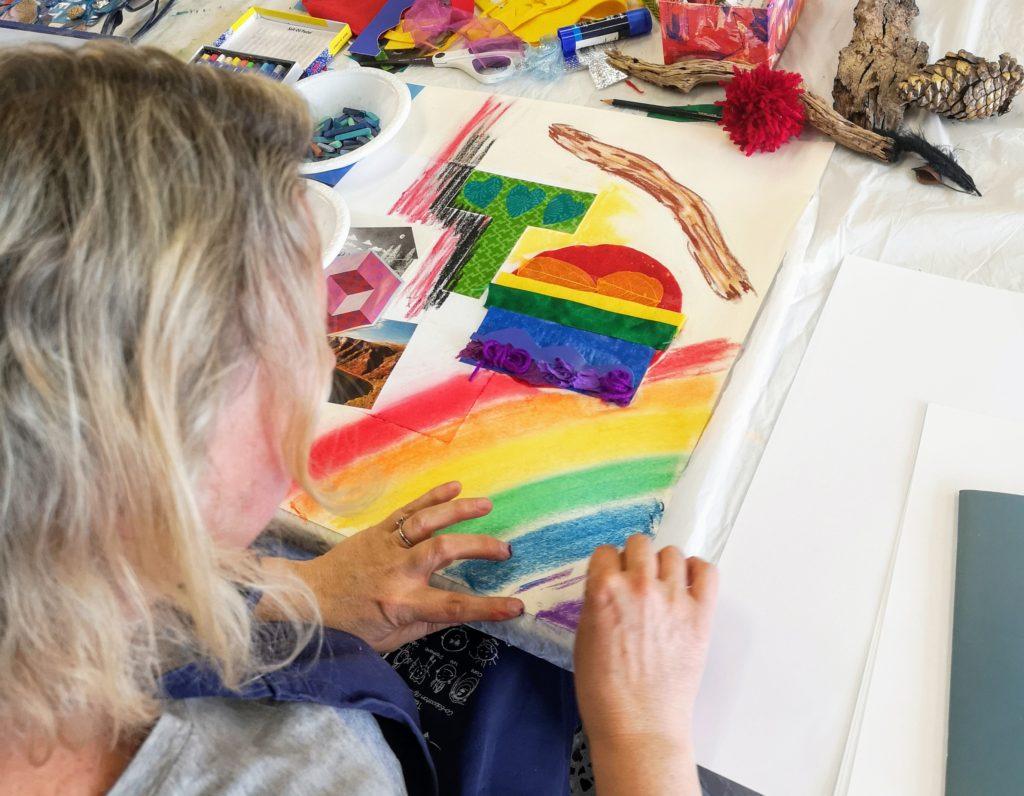
Arts Therapy an effective form of engagement with young people experiencing school refusal
Arts Therapy has the capacity to reach more disengaged and disadvantaged young people, who are also those most at risk of experiencing symptoms of mental ill-health.
Pearl Taylor AThR conducted her Master’s research into the use of Art Therapy with young people experiencing school refusal. A summary of her findings is attached.
Importantly, Pearl looked at the available evidence to design “Art-able: A phase I trauma stabilisation program for adolescents”.
“Art-able” was designed for school refusing adolescents who had experienced adverse childhood experiences or complex trauma. Pearl found that talk-based therapy was being underutilised by these young people due to lack of attendance, emotional regulation, interpersonal safety and higher-order thinking. Research showed that a phased-oriented approach is of benefit (Leenarts, et al, 2013). This approach is reflected in Blue Knot Foundation Practice guidelines for Complex Trauma (Kezelman & Stavropoulos, 2012).
The three stages of a phased-oriented approach are: Phase I – safety/stabilisation, Phase II – processing and Phase III – integration.
It is important to note that available quantitative research favours talk-based therapies and CBT, and focuses on Phase II of the overall process. There is a lack of research that includes the Phase I engagement and stabilisation or the Phase III personal integration stages of recovery. Multidisciplinary research demonstrates how the methodologies of art-therapies encompass all stages of recovery, as discussed in Pearl’s report.
Neuroscience and the study of how early trauma affects the brain, reveals that young people who have experienced trauma or disruption at an early stage of their life may develop neuro-behavioural patterns that are limited to the brainstem which is responsible for survival and automatic functions. If this occurs, the child can experience difficulty forming higher order processes for their experiences (Van der Kolk, et al. 2005).
Multidisciplinary research into the efficacy of art therapy in “reaching the hard to reach” showed that Art Therapy was “easier than talking”, (Cobbett, 2016), along with a positive correlation with increased life achievement, school attendance and self-esteem ratings (Prescott, et al. 2008). Symbolic form, material choice and sensory/kinaesthetic movement (Hinz 2009) are Phase I methodologies that aid the individual’s regulation, and in turn, their ability to enter into Phase II.
Pearl’s research is significant in highlighting that, especially when working with young people, Arts Therapy has the capacity to reach more disengaged and disadvantaged young people, who are also those most at risk of experiencing symptoms of mental ill-health.
Mixed methods research of this program is being conducted and will be released in 2022.
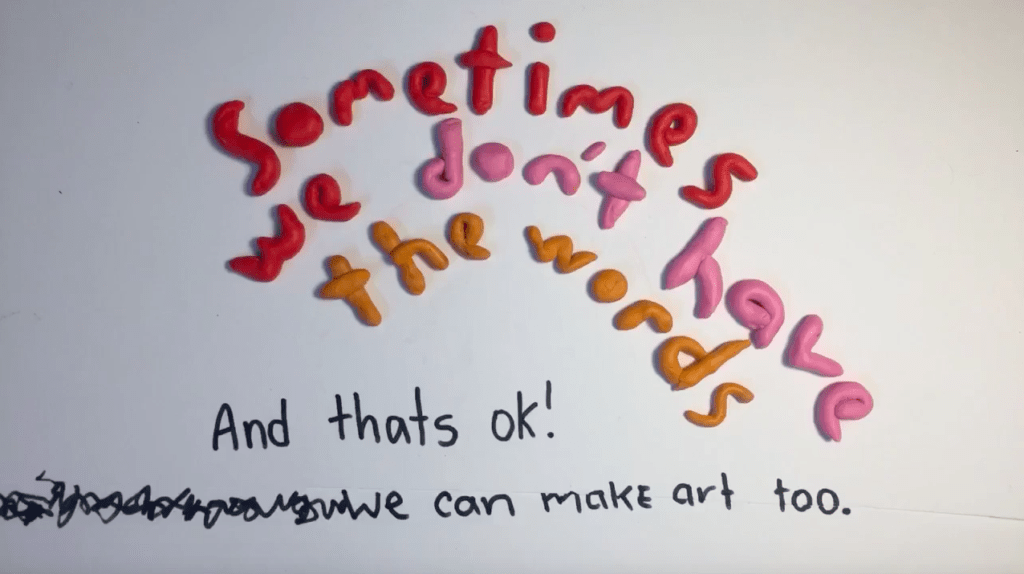
Evaluation of a School-based Creative Arts Therapy Programme for Adolescents from Refugee Backgrounds
“findings provide empirical support for school-based creative arts therapy interventions specific to refugee young people”
An important study to elucidate the efficacy of art therapy is that of Rosalind Quinlan, Robert D Schweitzer, Nigar Khawaja and Jane Griffin (2015), who conducted a controlled trial of creative arts therapy to address the psychosocial needs of students from refugee backgrounds.
Forty-two students participated in a therapy trial, comprising an intervention and control group. Mental health and behavioural difficulties were assessed pre and post intervention. Hopkins Symptoms Checklist-25 (HSCL-25) and the Strengths and Difficulties Questionnaire (SDQ) were used to assess wellbeing. Findings suggested an effect for a reduction in behavioural difficulties for the treatment group. A significant reduction in emotional symptoms was found for the treatment group.
Highlights of this study were:
- The intervention comprised creative arts therapy over the course of a school term.
- A significant reduction in emotional symptoms was found for the treatment group.
- Findings suggested an effect for a reduction in behavioural difficulties
- This contributes to the emerging evidence base for the efficacy of creative arts therapies
- School based creative art therapy programs are valuable with young people from refugee backgrounds
These findings provide empirical support for school-based creative arts therapy interventions specific to refugee young people.
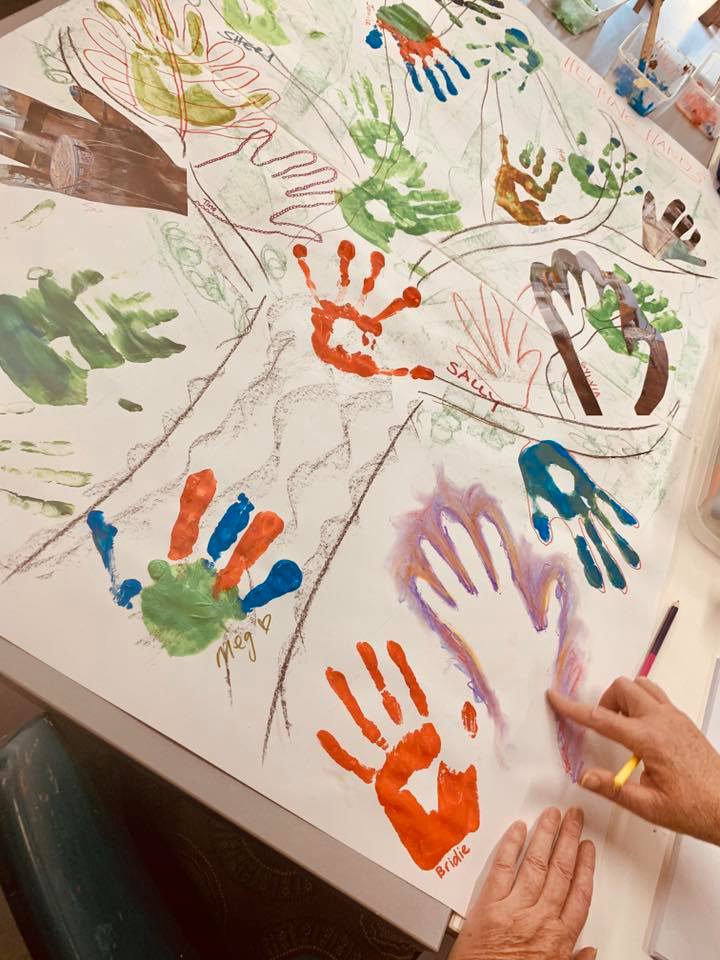
Risk mitigation and precedents for employing Arts Therapists in multi-disciplinary teams
A creative approach to therapy has enabled our young people to express themselves through embodied and creative pathways that are accessible to students for whom a more direct approach to therapy through talking would be inadequate.
Concerns that employing an Arts Therapist may pose greater risks than employing an Occupational Therapist, Psychologist, Social Worker or Nurse can be mitigated by the following strategies and precedents.
- All applicants are subject to a screening process including assessment of their qualifications and relevant experience working in mental health settings.
- All applicants undergo an interview process with suitably qualified and experienced practitioners who will be integral to determining the appropriateness of any candidate.
- Arts Therapists who are successful candidates will work within existing support systems including the school well-being team and will be adequately accountable, monitored and supervised in their roles.
- Arts Therapists who are successful candidates can maintain their continuing professional development to include specific training in working with suicidality and other harmful risks to young people.
There are many precedents for employing Professional Arts Therapists in clinical roles in multi-disciplinary teams working with children and young people. The Royal Children’s Hospital in Melbourne regularly advertises for clinicians and includes Arts Therapy qualifications in the Key Selection Criteria along with Occupational Therapy, Psychology, Social Work and Nursing. Wording such as the following is common in position descriptions:
– Completion of tertiary level Creative Art sTherapy degree from an accredited University or provider
– Must be a member of professional registering body that is a member association of AHPA
Numerous other reputable and leading organisations employ Creative Arts Therapists, including the sample listed in the attached fact sheet, “Where do ATs work?”
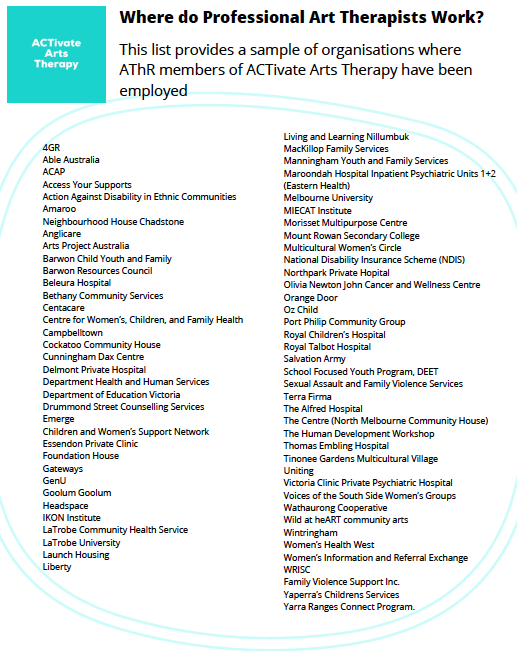
The National Disability Insurance Scheme (NDIS) sets a precedent for the recognition of Arts Therapists as valuable mental health practitioners working with thousands of Australians to support their mental health and well-being.
School Principal Juliet Cooper attests to the value of employing Creative Arts Therapists to work with students at her school:
A creative approach to therapy has enabled our young people to express themselves through embodied and creative pathways that are accessible to students for whom a more direct approach to therapy through talking would be inadequate. We would like to see other schools have further opportunity to employ Creative Arts Therapists as Mental Health practitioners in their schools, as we feel broadening the definition and approach to this role would more adequately address the diversity that exists amongst our young people in educational settings.
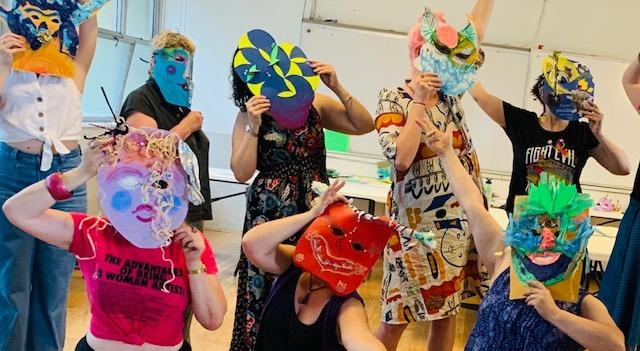
Summary
Arts Therapists are highly trained and skilled mental health practitioners that can help meet the demand for mental health services in the currently under resourced Victorian mental health workforce.
The 2019 World health Organisation report shows that there is strong evidence for the efficacy of Arts Therapy to support mental health and well-being.
In Australia, Creative Arts Therapy is well established with Government accredited and TEQSA regulated Bachelor and Masters level (AQF Levels 7 and 9) training programs.
Creative Arts Therapy is a self-regulating profession in Australia and membership of peak bodies ensures course accreditation, insurance, ongoing professional development and clinical supervision requirements. Registering bodies are organisational members of the Allied Health Professions Australia (AHPA).
Local Australian studies show that Arts Therapists have been effective in supporting students in schools, increasing engagement, increasing help seeking, increasing productive coping strategies, and decreasing anxiety as well as decreasing non-productive coping strategies such as misuse of alcohol and other drugs.
Strategies and precedents exist to ensure that employing Arts Therapists to work as mental health practitioners in schools poses no greater risk than employing other Allied Health Professionals. As Allied Health Professionals, Arts Therapists are already recognised and employed in many hospitals, community health and education settings, and are recognised through the National Disability Insurance Scheme (NDIS).
Conclusion
Creative Arts Therapists are highly trained and skilled mental health practitioners that can help meet the demand for mental health services in the currently under resourced Victorian mental health workforce.



3 Comments
Annie Wilson
I’m a second year MA student, in Art Psychotherapy at Lead Beckett Uni in the UK. This has been such an informative read, and is really helping me formulate my ideas for my upcoming dissertation which I’m hoping to base on Australian Art Therapy seen through the lens of working within the indigenous communities. I’m hoping to discuss how Australian Art Therapy is different from our European ways? not sure how as yet but feel like you guys have a more holistic approach? Anything you can send my way would be greatly appreciated as I have so much to learn, but feel this subject matter has so much lean from.
Carla van Laar
Hi Annie! Thanks for having a read and your response, much appreciated.
Have a look at the program for our Creative Mental Health Forum in May. It has been put together especially to show case how the Arts Therapies are holistic, diverse, inclusive and value lived experience.
There are a number of presenters whose work will interest you! I know you won’t be able to attend but you might like to contact individuals directly.
https://carlavanlaar.com/program-2021-creative-mental-health-forum-and-self-care-retreat/
🙂 Carla
Janeen Cameron AThR
Excellent read Carla. A great resource!